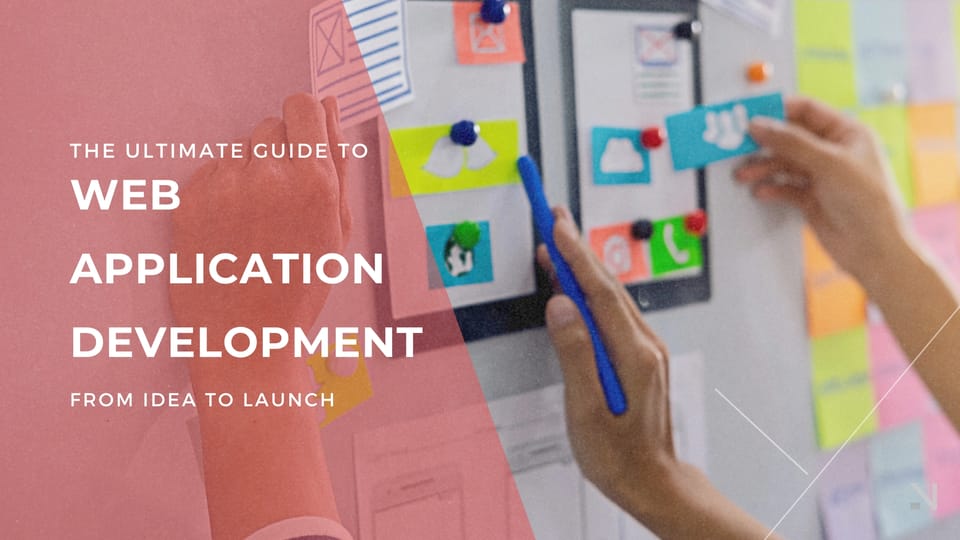The Ultimate Guide to Web Application Development: From Idea to Launch
Narima Digital •

In today's digital age, a web application is not just an option–it's a necessity for businesses looking to thrive in a competitive marketplace. Whether you're a startup aiming to disrupt the industry or an established company seeking efficiency, web applications can provide scalable, user-friendly solutions. This guide walks you through the step-by-step process of web application development to help you transform your ideas into successful launch.
What is Web Application Development?
Web application development is the process of creating a software application that runs on a web server and is accessed through a web browser. Unlike traditional software, web apps don’t need to be downloaded or installed, making them accessible from any device with internet access.
Examples of Popular Web Applications:
- Google Docs: A cloud-based word processor that enables real-time collaboration.
- Slack: A communication tool for teams with chat, file sharing, and integrations.
- Airbnb: A platform connecting travelers with hosts offering accommodations.
Stages of Web Application Development
Developing a web app requires careful planning and execution. Below are the key stages:
Planning: The Blueprint of Success

Before you dive into coding, planning is crucial.
This stage defines the foundation of your web application. The first and most critical stage in web application development is planning. This is where you define the foundation of your web application, setting clear objectives and understanding your audience's needs. Start by identifying the problem your app will solve and who your target users are. For instance, if you're building an e-commerce platform, focus on features like intuitive navigation, secure payment gateways, and user-friendly search functions.
Market research is equally essential at this stage. Analyze competitors to understand what works and what doesn’t, then brainstorm unique features that will set your app apart. Once you’ve gathered all the necessary information, compile it into a detailed requirement document that outlines the app's features, expected timeline, and budget. This document will act as your roadmap throughout the development process, ensuring all stakeholders are aligned.
- Define Your Goals:What problem does your app solve? Who is your target audience? Example: A startup creating an e-commerce platform should focus on user experience and payment security.
- Research Your Market:Analyze competitors, identify gaps, and brainstorm features that set your app apart.
- Create a Requirement Document:Write a clear scope of work, including features, timelines, and budgets.
Design: Crafting the User Experience (UX/UI)

A well-designed app keeps users engaged and encourages repeat visits.
The design stage focuses on creating a seamless and visually appealing user experience. Begin with wireframing, which provides a skeletal framework of your application’s layout. Tools like Figma, Sketch, or Adobe XD are excellent for this purpose. Wireframes help you visualize the structure and flow of your app before diving into development.
User experience (UX) is at the heart of this stage. The goal is to make navigation intuitive and interactions effortless. For example, Airbnb’s design simplifies booking accommodations with a clean interface and minimal clicks. Pair this with user interface (UI) design, which focuses on the app’s aesthetics—colors, fonts, and branding elements—to ensure it resonates with your target audience. A well-designed app not only looks good but also builds trust and keeps users coming back.
- Wireframing: Create a visual blueprint of the app’s layout and structure. Tools like Figma or Sketch can help.
- Focus on UX:Ensure navigation is intuitive, buttons are accessible, and content is easy to read.Example: Airbnb’s clean, simple interface makes booking accommodations effortless.
- UI Design:Choose a modern, visually appealing design that aligns with your brand identity.
Development: Bringing App to Life

This stage involves coding the app using appropriate technologies and frameworks.
Development is where your app transitions from concept to reality. This stage is divided into two primary components: front-end and back-end development.
The front-end is what users see and interact with. Technologies like HTML, CSS, and JavaScript are used to create the user interface, while frameworks like React.js or Vue.js enhance performance and scalability. For example, a dynamic product catalog on an e-commerce site relies heavily on front-end development.
The back-end, on the other hand, is the engine that powers your application. It handles server-side operations, database management, and APIs. Back-end development ensures data flows seamlessly between the user interface and the server. Technologies like Node.js, Python, or Ruby on Rails are commonly used. Choosing the right database, such as MySQL for structured data or MongoDB for unstructured data, is also critical at this stage to ensure scalability and performance.
- Front-End Development:Focuses on what users see and interact with, using technologies like HTML, CSS, and JavaScript. Frameworks such as React.js and Vue.js are popular choices.
- Back-End Development:Builds the server-side logic, database management, and APIs. Technologies like Node.js, Python, or Ruby on Rails are commonly used.
- Database:Choose a database that fits your app’s needs. MySQL or MongoDB are popular options for scalability and flexibility.
Testing: Ensuring a Bug-Free Experience

Testing ensures your app is functional, secure, and user-friendly.
Testing is an often underestimated stage, but it is vital to delivering a high-quality web application. Comprehensive testing ensures that your app is functional, secure, and provides a smooth user experience.
Start with functional testing, which ensures every feature works as intended. For instance, check if login forms, search bars, and payment systems are performing without errors. Next, conduct performance testing to evaluate how your app handles heavy traffic or large data loads. This is particularly important for apps expecting a global user base.
Security testing is another critical step. Ensure sensitive data like user credentials or payment information is protected from breaches. Finally, perform user testing, where real users interact with the app and provide feedback on usability. Their insights can uncover overlooked pain points and guide last-minute improvements.
- Functional Testing:Does every feature work as intended?
- Performance Testing:Can the app handle a large number of users simultaneously?
- Security Testing:Protect sensitive data and prevent unauthorized access.
- User Testing:Involve real users to gather feedback on usability and identify pain points.
Launch: Deploying Your App

After rigorous testing, it’s time to launch your app.
After rigorous testing, your web application is ready to go live. Launching involves deploying the app to a reliable hosting server. Platforms like AWS, Google Cloud, or Microsoft Azure are popular for their scalability and security features.
Ensure all DNS configurations are properly set up so users can easily access your app. But launching doesn’t stop at deployment—this is where marketing comes into play. Promote your web app through social media campaigns, email marketing, and even paid ads to attract users. Collect feedback post-launch to identify areas for improvement and plan future updates.
- Choose a Hosting Provider:AWS, Google Cloud, or Microsoft Azure are reliable options.
- Deploy the App:Upload the app to the hosting server and ensure proper DNS configuration.
- Marketing Your App:Promote your web application through social media, email campaigns, and paid ads to attract users.
How Much Does it Cost to Build a Web Application?
The cost of building a web application depends on several factors, such as complexity, features, and the development team’s location. Here’s a rough estimate:
- Simple Web Apps: $5,000 - $15,000 (e.g., basic e-commerce apps).
- Medium Complexity Apps: $20,000 - $50,000 (e.g., apps with user dashboards, APIs, etc.).
- Complex Apps: $50,000+ (e.g., apps with AI integrations, custom features).
To optimize costs, consider partnering with a reliable team like Narima that offers scalable, custom solutions tailored to your budget.
Why Choose Narima for Your Web Application Development Needs?
At Narima, we specialize in creating innovative, user-friendly web applications that drive business growth. Our end-to-end approach ensures your app is tailored to your unique requirements, from concept to launch.
Key Advantages of Working with Narima:
- Expertise in cutting-edge technologies like React.js, Node.js, and AWS.
- A collaborative team that values your input throughout the development process.
- Proven track record of delivering scalable and secure solutions.

Building a web application may seem overwhelming, but with the right strategy and team, it becomes a seamless process. By following these stages—planning, designing, developing, testing, and launching—you can create a web app that meets your business goals and delights your users.
Are you ready to bring your web app idea to life? Contact Narima today and let’s get started!


